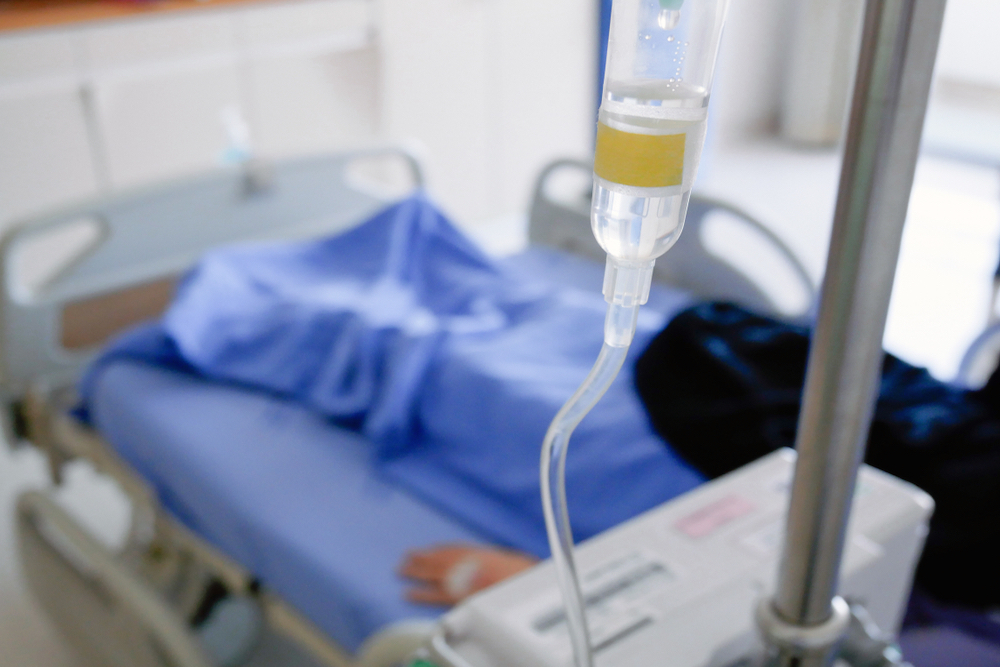- Many recovering addicts fear that surgery and the ensuing exposure to opioids may trigger relapses.
- Opioid-free local anesthesia, sedatives, or general anesthesia can be safely administered during surgery.
- Post-surgical pain management is also possible through the use of various non-opioid drugs.
Opioid addiction is now referred to as an epidemic in the United States. According to the Center for Disease Control and Prevention (CDC), an average of 91 Americans die each day from opioid overdoses.
To curb this trend, the American Society of Anesthesiologists (ASA) now strongly encourages patients to inquire about opioid alternatives following surgery.
Below you will find a comprehensive list of non-opioid medications and the science behind their rational use, from the waiting room and surgery to post-surgical recovery and pain management.
The basic principles of pain management
Although opioids do provide very real benefits, doctors are now struggling with the question of what to give addicts or recovering addicts in need of anesthesia and post-surgical pain management.
No surgeon or anesthesiologist wants their patient to suffer. For this reason, many medical professionals and organizations offer guidelines regarding effective pain management.
These common principles can be summarized as follows:
- Pain relief is key.
This is especially important for anesthesiologists, given that inadequate pain control during surgery can lead to shock. Acute pain during and after surgery should be treated like a medical emergency.
- Pain should be measured regularly.
Pain levels rise and fall, and it can take time to determine the appropriate post-surgical dosage. Your surgeon should be regularly screening your experience by talking to you about any discomfort or side effects you are experiencing.
- Pain is subjective.
Surgeons should not compare one patient’s postoperative experience with another’s. Pain management strategies that work for one patient may not work for another. What’s more, when asked to rate pain in a scale of 1-10, one patient’s “6” could easily be another patient’s “8.”
- Pain should be tackled from multiple angles.
There is more to pain management than just drugs. Depending on the procedure in question, surgeons should be turning to other strategies, like heating and cooling, compression, physical therapy, and other methods to complement pain pills.
- Patients and caregivers should be educated about pain management.
Everyone involved should understand what an acceptable level of discomfort is and how to responsibly handle serious pain medications.
Addiction recovery: what to consider before surgery
If you have a history of opioid abuse, the following questions should be openly addressed with your healthcare providers before undergoing surgery.
- Are you taking medications to help you stay in recovery?
If you are currently using Methadone, Suboxone, or Naltrexone, your doctor and anesthesiologist need to know so they can plan ahead.
- Do you occasionally use street opioids?
Meeting with an interdisciplinary team can help you plan for the recovery path ahead before making the decision to undergo surgery.
- Are you in recovery and abstinent from any opioids?
If so, you may wish to avoid opioids altogether. Depending on the extent of the surgery, alternative medications can be used by surgeons and anesthesiologists.
Alcoholism and pain management
Current and former opioid addicts aren’t the only patients that need concern themselves with alternative pain management options. The use of opioids by someone who is prone to heavy drinking presents its own unique set of challenges.
Alcohol and opioids have well documented cross-tolerance effects. In other words, an increased tolerance to alcohol could mean an increased tolerance to opioids, even in patients who don’t regularly use or abuse them.
What’s more, alcohol and opioids are both central nervous system (CNS) depressants. In fact, opioids enhance the effects of alcohol and can lead to serious complications such as respiratory depression.
Finally, alcoholism is its own form of substance abuse, and alcoholics are more susceptible to developing other drug dependencies.
Opioid-free anesthesia: recent studies
Anesthesiologists have recently developed techniques for opioid-free anesthesia (OFA) that can include a mixture of acetaminophen, NSAIDs, oral anti-seizure drugs, magnesium, and sedatives.
A 2017 study at Select Physicians Surgery Center in Tampa, FL looked at the effectiveness of general anesthesia without morphine or other opioids. Instead of the usual medications, patients received varying combinations of ketorolac, lidocaine, magnesium, and sub-anesthetic ketamine.
The study followed 1,009 patients through surgery and pain treatment — both the patients and surgeons involved reported success.
This new strategy for pain management holds promise for more than just struggling and recovered addicts. Dr. David Samuels, who lead the study, noted that fentanyl, the most commonly used opioid in general anesthesia, caused increased pain sensitivity after the fact, a phenomenon known as opioid-induced hyperalgesia. However, 64% patients who received the non-opioid general anesthetic did not require any pain relievers in the post-anesthesia care unit (PACU).
What’s more, only 11% of these patients experienced postoperative nausea, as opposed to the usual 50-80% of patients who receive traditional general anesthesia.
Note that these efforts are still in their budding stages. There’s no guarantee that your prospective surgeon and anesthesiologist will be on board with opiate-free general anesthesia.
Monitored Anesthesia Care: local anesthesia with sedation
Whether your procedure requires local or general anesthesia will depend on the procedure itself and your surgeon’s best practices.
Local anesthetics are applied to the area where the effect is needed and work by blocking nerve sensations that cause pain. Although they do not contain opioids, some research suggests that opioid tolerance can create the need for higher dosages and even delay their onset.
In contrast, general anesthesia is a deep state of unconsciousness that almost always involves opioids.
The cost of non-opioid general anesthesia is usually higher, since multiple medications and complex procedures are required — an approach known as multimodal anesthesia — to achieve an effect similar to potent opioids. As such, many anesthesiologists are reluctant to offer this option. Instead, an increasing number of medical practitioners and patients are now favoring an approach known as Monitored Anesthesia Care (MAC).
Monitored Anesthesia Care (MAC) is a safe approach that allows for faster recovery after surgery than general anesthesia. Sedating drugs are given first through an IV, at the same time relieving anxiety, pain, and increasing comfort. Local anesthesia is then applied to the area of surgery.
MAC is cost-effective, as it requires a lower dose of drugs than general anesthesia. Anti-anxiety medications can also be administered before the procedure to make the patient feel more relaxed.
What local anesthetics are used?
With MAC, a local anesthetic is usually injected into the skin and muscle around the surgical site to numb it.
- Lidocaine
The most commonly used local anesthetic in the United States, Lidocaine is low-cost and suitable for short and simple procedures.
- Bupivacaine (Marcaine™)
Bupivacaine has a lower risk of adverse effects and is a better option for longer procedures than Lidocaine, but the injection may be more painful.
- Exparel
Exparel is a slow-release Bupivacaine injection that reduces the need for opioids after surgery. It is given as one dose during surgery and lasts for up to three days after to provide effective pain relief.
Exparel is superior to standard Bupivacaine, but its higher price has been somewhat controversial ($285/vial for Exparel and $3/vial for Bupivacaine). In the long-run, Exparel may actually be more cost-effective as it cuts your hospital stay and the need for additional painkillers.
- Tumescent anesthesia
Tumescent anesthesia is a type of local anesthesia used for liposuction that can be combined with IV sedation to increase comfort and reduce pain.
- Other local anesthetics
Other local anesthetics include Mepivacaine, Prilocaine, Ropivacaine (Naropin) and Articaine (Septocaine).
Ropivacaine may reduce the need for opioids, and both the brand name and generic cost under $50 (standard supply of 100mm). Septocaine is used for dental procedures.
What sedatives are used?
Several non-opioid drugs can be used as sedatives when following the MAC approach:
- Midazolam (Versed)
Midazolam belongs to an anti-anxiety group of drugs known as benzodiazepines. It induces sedation and amnesia during MAC and pain relief after surgery.
- Propofol (Diprivan)
Propofol is a less-sedating and frequently used drug. Propofol also reduces nausea and vomiting — symptoms that often require additional treatment and are worsened by opioids and pain itself.
- Dexmedetomidine (Precedex)
Dexmedetomidine and Clonidine belong to the same class of sedative painkillers that act on the brain and blood vessels. Dexmedetomidine is newer, also relieves anxiety, and has fewer side-effects.
Recovery is slow and it may not be safe for elderly patients, as drops in blood pressure and heart rate can occur with its use.
- Non-Steroidal Anti-Inflammatory Drugs
NSAIDS such as Ketorolac are another safe option.
- Ketamine with Propofol (Ketofol)
Ketofol offers an almost ideal combination for sedation that tackles both pain and nausea. Propofol is given first to induce rapid sedation, followed by Ketamine to block pain pathways.
Newport Beach, California’s Dr. Barry L. Friedberg reviewed 80 clinical trials and found that Ketofol increases patient satisfaction, shortens recovery time, and eliminates the need for opioids.
Opioid-free pain management after surgery
Following surgery, less severe pain can be treated with prescription doses of non-addictive pain medicine. Some opioid-free drugs can also be combined to provide optimal pain relief.
Opioid-free medications for pain relief after surgery include:
- NSAIDs
Common nonsteroidal anti-inflammatory drugs include Ibuprofen (Advil, Motrin IB) and Naproxen (Aleve, Anaprox), Celecoxib (Celebrex), and Ketorolac.
Celecoxib may be more suitable for people prone to gastric bleeding or kidney problems, but carries the risk of potential cardiovascular adverse effects. Ketorolac provides strong pain relief, but should not be used for more than five days. Ibuprofen is a popular post-procedure choice but may increase the risk of bleeding.
Note that while you can purchase some painkillers over-the-counter, you shouldn’t seek to manage your own pain and dosages. Appeal to your doctor for a prescription with the appropriate dose and only take the painkillers prescribed to you.
- Acetaminophen (Tylenol)
Acetaminophen may also be a good choice if its blood thinning properties aren’t a concern. It can be used alone or in combination with NSAIDs for a synergistic effect. Acetaminophen alone should be taken regularly after surgery to achieve the desired effect.
Acetaminophen doesn’t carry the risk of damaging the stomach lining, unlike Ibuprofen and Naproxen.
- Tramadol
If your pain is more severe, you may be looking at a prescription for a less addictive medication like Tramadol, which is an opiate agonist and not technically classified by the federal government as a narcotic. Learn if Tramadol shows up on a drug test?
Tramadol is an antidepressant with a minor effect on opioid receptors. It’s commonly considered a good choice for patients for whom addiction is a concern. Some doctors may also try low dosages of stronger narcotics, like hydrocodone or oxycodone, but this has shown mixed results.
- Bupivacaine
Also, ask your prospective surgeon about non-opioid anesthetics like bupivacaine. This drug, marketed under the brand names Marcaine, Sensorcaine, and others, is similar to lidocaine. Its effects generally last approximately 12 hours. Learn if Bupivacaine shows up on a drug test?
- Exparel
Exparel’s unique composition creates a slow release of the anesthetic that lasts up to three days. In this way, the anesthetic can become an effective post-surgical pain management solution for recovering addicts. In fact, the drug is so effective that many patients are opting to use it, regardless of their history with opioids.
- Gabapentin (Gralise, Horizant, Neurontin) and Pregabalin (Lyrica)
These are anti-seizure medications. They can be given both before and after surgery to reduce pain. Prices vary depending on the brand. What is a Gabapentin high and learn why Gabapentin is the latest craze among drug abusers?
- Ketamine (Ketalar)
Ketamine affects pathways in the brain and spinal cord, rapidly altering the sensation of pain. Low doses of Ketamine can provide effective and safe pain relief. Due to its unique action, Ketamine reduces the need for opioids but does have adverse effects which need to be discussed with your doctor.
What about medical cannabis?
Many pain clinicians and researchers agree that medical cannabis shows promise for managing pain, but more research and regulations are needed to assess its safety and efficacy. Learn how long Marijuana stays in your system?
Conflicting opinions among clinicians are causing a steaming debate. Some doctors think that the risk of triggering addictive habits with cannabis outweighs any potential benefits. Others, like Dr. Mark Hashim, a board-certified Anesthesiologist in Hudson, FL, hold that medical cannabis may even help patients wean off opioids and improve anxiety.
“I’ve given it to patients who are in recovery and haven’t had an issue,” Hashim says.
Check your local laws and talk to a healthcare professional if you are considering medical cannabis for pain relief. Here are the best recommendations to prepare for a cannabis drug test.
Resources for recovering addicts
Despite these options, opioids remain difficult to avoid, especially when major surgery is involved. Thankfully, there are other resources at your disposal that can help you through a difficult postoperative transition.
Dr. Stuart Gitlow, former president of the American Society of Addiction Medicine (ASAM), suggests that surgeons seek the counsel of addiction specialists when working with recovering addicts.
Having an addiction specialist on hand can help identify opioid misuse early on and allow actions to be taken before the problem grows. However, demand for these specialists is very high these days, so there’s no guarantee one will be available to you.
In the meantime, talk to your surgeon about making a postoperative health care plan. Agree to the conditions of this plan prior to surgery to help you stay accountable should you find yourself at risk of developing or worsening a dependency on opiates.
- Minimum effective dose
Agree to keep dosages down even where minor discomfort is involved.
- Periodic weaning
In order to best assess the minimum effective dose, work with your surgeon to scale back the dose on a semi-regular basis and reassess the pain.
- Drug screening
Agree in advance to a regular schedule of drug screening tests after surgery. This will help to keep you accountable and make it easier for your surgeon to get you the aid you need should they see signs of opioid abuse developing.
- One opioid-prescribing physician
In case pain complaints transform from genuine need to drug-seeking behavior, it’s helpful if all your medication comes from one source. In this way your surgeon or attending physician can better monitor any signs you may be relapsing.
- Recovery drugs
There is some evidence to suggest that recovering addicts who are still taking a recovery drug like methadone or buprenorphine are actually less susceptible to relapse due to pain medications.
It’s possible that going back on opiates and later resuming addiction treatment for a time will help patients through the postoperative period, including easing the effects of opioid withdrawal symptoms when combating physical dependence.
In addition to the measures outlined above, reach out to close friends and family, as well as your primary physician. Tell them that you’re planning surgery and what your concerns are. The bigger your support network, the easier recovery will be.









